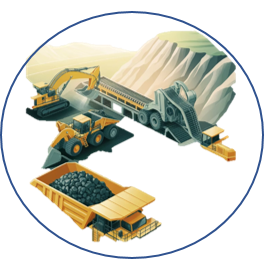Mining and allied industries involve bulk material handling and transportation at almost every step. These operations are carried out by deploying a wide range of machinery. The design and construction of such machinery depend on the site-specific requirements. Such machinery includes conveyors, feed and discharge devices, crushers, screens, and deployed in different systems. There are bulk material storage systems including silos, bins, bunkers, and stacking, blending, and reclaiming machinery. The properties of bulk materials to be handled and flow patterns are examined to help develop methods for improving stockpile design, blending/mixing accuracy and preventing segregation in bins, feeders and chutes. Mineral Industry uses
Thydraulic and pneumatic transport as well as winding of bulk materials from underground mines.
Course Objetives
This course aims to provide the basic concepts of bulk materials properties, handling and transport system design. The emphasis is placed on developing engineering management problem solving skills. By the end of the course, students will be able to:
· characterize bulk solids
· explain how friction, cohesion, compressibility, and other properties affect the flow of solids through various types of feeders, chutes, reactors, bins, and hoppers.
· explain bulk material handling systems in ore beneficiation and coal washing
· describe crushing and screening equipment
· classify conveyor systems and calculate power requirement for conveyors
· describe the bulk material storage and reclaiming systems and equipment used in these systems
· determine the bin wall and feeder loads
· design hydraulic and pneumatic conveying systems
· describe mine winding systems
